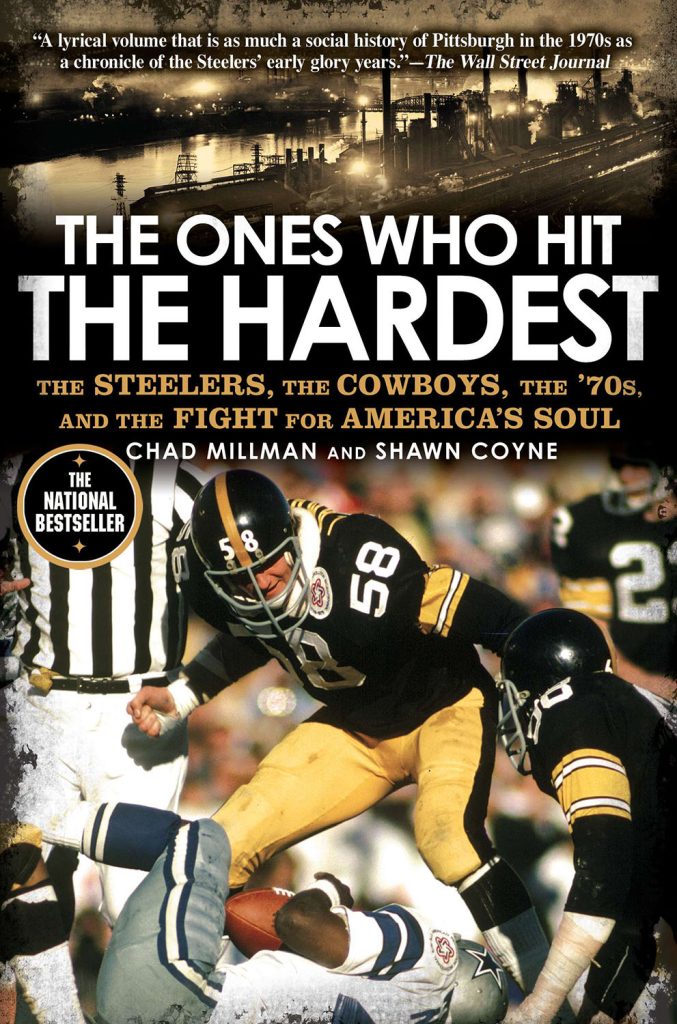The Ones Who Hit the Hardest
 Buy the Book: Amazon, Apple Books, Barnes & Noble, Books-A-Million
Buy the Book: Amazon, Apple Books, Barnes & Noble, Books-A-MillionPublished by: Gotham
Release Date: 09/02/2010
Pages: 336
ISBN13: 9781592405763
Overview
In the 1970s, the city of Pittsburgh was in need of heroes. In that decade the steel industry, long the lifeblood of the city, went into massive decline, putting 150,000 steelworkers out of work. And then the unthinkable happened: The Pittsburgh Steelers, perennial also-rans in the NFL, rose up to become the most feared team in the league. And they played in the spirit of their city: hard-nosed and relentless.
In The Ones Who Hit the Hardest, Chad Millman and Shawn Coyne trace the rise of the Steelers amidst the backdrop of the fading city they fought for, bringing to life characters such as: Art Rooney, the owner of the team so beloved by Pittsburgh that he was known simply as “The Chief”; Chuck Noll, the headstrong coach who used the ethos of steelworkers to motivate his players; Terry Bradshaw, the strong-armed and underestimated QB; Joe Greene, the defensive tackle whose fighting nature lifted the franchise; and Jack Lambert, the linebacker whose snarling, toothless grin embodied the Pittsburgh defense.
Every story needs a villain, and in this one it’s played by the Dallas Cowboys. As Pittsburgh rusted, the new and glittering metropolis of Dallas, rich from the capital infusion of oil revenue, signaled the future of America. Indeed, the town brimmed with such confidence that the Cowboys felt comfortable nicknaming themselves “America’s Team.” Throughout the 1970s, the teams jostled for control of the NFL—the Cowboys doing it with finesse and the Steelers doing it with brawn—culminating in Super Bowl XIII in 1979, when the aging Steelers attempted to hold off the Cowboys one last time.
The Idea
After I graduated from high school I came to New York for a weekend with my dad. We took trips like this every summer. One year it was Madison, Wis., just a couple hours from my house outside Chicago, for three days of biking through farm country. My dad was a cyclist. I was not.
The New York trip, however, was more my speed. We saw a Yankees game. And the most exercise we got was walking around town. But, really, the only thing I wanted to see was down the street from our mid-town hotel: The Museum of Broadcasting (now known as the Paley Center for Media).
Every show ever created could be watched again and again. Edward R. Murrow railing against McCarthy, I Love Lucy, Three’s Company, Fantasy Island, the time the Fonz literally jumped the shark. Plus there was an entire library of sporting events. That’s what I was there for. I loved football and I loved TV. I still do. And with the hundreds of miles of history on tape I could have watched that day, the thing that appealed to me most was Super Bowl XIII, between the Pittsburgh Steelers and the Dallas Cowboys, played on January 22, 1979.
For people born in the late 1960s and early 1970s, it didn’t matter where your everyday football fan loyalty lied—the Bears, the Rams, the Giants—at the end of a season you would inevitably be rooting for the Steelers or the Cowboys. Those were the teams who always seemed to be in the Super Bowl. You couldn’t be a fan or both; and you couldn’t be indifferent. The franchises were polar opposites; representing not just the cities they played in but also the type of person you, as a fan, aspired to be. Blue collar vs. white collar. Family owned vs. corporate managed. These were epic battles, played by two teams who appeared in six combined Super Bowls between 1970 and 1979. Twice they played each other— in Super Bowl X and XIII. Both games were considered the best NFL championship games ever played as soon as they ended.
When I watched the replay that day in the museum I saw nearly a dozen future Hall of Famers take the field, including both starting quarterbacks, both starting running backs and both coaches. I watched peaceful Steeler running back Franco Harris stand up to the boisterous Cowboys linebacker Hollywood Henderson. And I watched Roger Staubach fall four points short of pulling off a miracle comeback in the final minutes of the game. When it was over I thought, too bad I can’t stay here all weekend and just watch this again and again.
Which is why, when my agent Richard Abate had the idea for me and Shawn Coyne to write this book, it was a no-brainer. But I truly knew we had the seed for something that could resonate with people beyond the football-loving community when I mentioned it to my wife, who’s so uninterested in sports she has yet to read any of my books. At least willingly. Her response to this idea, however, was, “Ooh, that sounds fun. I used to love the Cowboys when I was growing up.”
For the year it took to research and write the book, I was able to revisit Super Bowl XIII, and every other Steeler highlight and lowlight everyday, talking to Harris and Rocky Bleier and safety Mike Wagner and Joe Greene and dozens of other players and coaches. These guys seemed to enjoy retelling stories they’ve told a thousand times the past 30 years as they did playing in the games themselves. Which made it a lot of fun to write.
And hopefully fun to read. Even for my wife.